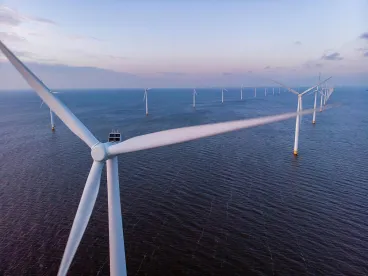As a top priority for the Biden Administration and a key component of energy transition plans, offshore wind energy development is front and center and receiving a lot of attention. The Biden Administration has announced a commitment to create 30 gigawatts of electricity via US offshore wind by 2030. Congress provided a boost to offshore wind development late last year via a 30% investment tax credit to projects that start construction before 2026. And just last week, Interior Secretary Deb Haaland announced plans to spur that development by offering a slate of offshore wind lease sales by 2025 in federal waters off the East, Gulf, and West Coasts.
Offshore wind development is accelerating. For developers, utilities, and investors considering offshore wind opportunities, here are five things you should know right now:
-
BOEM is the Lead Permitting Agency for Offshore Wind Development
BOEM was created in its current form in 2011, in the wake of the Deepwater Horizon spill that prompted DOI to divide the former Mineral Management Service (renamed the Bureau of Ocean Energy Management, Regulation and Enforcement) into three distinct entities to carry out its mandate(s) more effectively. Among those entities, BOEM was formed to manage development of energy and mineral resources on the US Outer Continental Shelf. The energy side of BOEM’s mission encompasses both offshore oil and gas development as well as offshore wind. Because of this, despite the domestic offshore wind industry’s nascent state, BOEM has significant experience with project development and permitting, including environmental reviews, in the oil and gas context.
With under 600 employees, BOEM is a small agency. The offshore wind industry has raised concerns about understaffing at BOEM, given the resulting permitting delays and related implications for key federal tax incentive deadlines. The impacts of understaffing could grow in light of the anticipation of additional lease sales and increased development. The Administration’s latest budget proposal for Fiscal Year 2022 shows a budget increase for BOEM to account for its role in offshore wind development, however, including $45.8 million for renewable energy management (an increase over the $28.5 million 2021 enacted budget) out of an overall $227.8 million total budget request for the agency.
-
An Offshore Wind Project Requires a Multi-Step Leasing and Development Process
The authorization process for an offshore wind project is divided into four phases, each of which encompasses a number of important steps that collectively can take years to complete:
(1) Planning and Analysis – This initial phase involved federal identification of Wind Energy Areas, which are offshore areas appropriate for wind energy leasing, and conducting environmental reviews in concert with Tribes, states, and Federal agencies with responsibilities for natural resources. Parties interested in potential leases of Wind Energy Areas should monitor agency activities to identify Wind Energy Areas and consider potential engagement, such as responding to a BOEM Call for Information and Nominations, published in the Federal Register, as this information is used in identifying the lease area(s) and developing appropriate environmental analysis and leasing provisions.
(2) Leasing – The leasing phase leads to lessees receiving exclusive rights to seek BOEM approval for offshore wind development within specific leased areas. The leasing process varies depending on whether the process is competitive or noncompetitive, if BOEM determines after public notice that no competitive interest exists. If the former, BOEM issues a Sale Notice of its intent to hold a lease sale; if the latter, BOEM negotiates a lease directly. The commercial lease only gives the lessee the exclusive right to seek BOEM approval for offshore wind development of the leased area; it does not confer any right to construct facilities. Parties who wish to obtain a lease during the leasing phase should monitor Proposed Sale and Final Sale Notices, both published in the Federal Register, and consider submitting comments on the proposal during the public comment period on the proposal, as well as participating in the lease auction to bid on the lease(s) for sale.
(3) Site Assessment – The site assessments phase includes the lessee’s efforts to characterize the site through various studies (e.g., avian surveys, archaeological), and develop a Site Assessment Plan (SAP) for BOEM review and approval. The SAP describes the lessee’s proposed site assessment activities for the lease area in detail, including planned construction and installation of a meteorological tower or buoys, and requires BOEM approval before the lessee can conduct the site assessment activities. BOEM can approve, approve with modification, or disapprove a SAP.
(4) Construction and Operations – The final phase concludes with BOEM and other relevant agencies completing their reviews and authorizing the project. This phase includes the submission of a Construction and Operations Plan (COP), environmental and technical reviews by BOEM, and reviews by other agencies with purview over certain aspects of the project. Similar to the SAP, BOEM can approve, approve with modification, or disapprove a COP. The developer must also submit a decommissioning plan for facilities on the lease area before the end of the lease term.
Collectively, these stages can be quite lengthy. BOEM estimates that Planning and Analysis may take approximately two years; Leasing may take one to two years; Site Assessment can take up to five years; and Construction and Operations can take two years. In practice, these timeframes may vary, although, BOEM recently approved Vineyard Wind to start commercial operation six years after it issued a lease in 2015. Vineyard Wind is the US’s first large-scale offshore wind project which, will generate 800 megawatts (MW) of electricity starting in 2023. BOEM aims to complete reviews for upcoming projects in a shorter timeframe.
-
An Offshore Wind Project Requires a Complex Array of Permitting and Environmental Reviews
As part of BOEM’s review of an applicant’s COP, it conducts a review under the National Environmental Policy Act (NEPA) as well as reviews under other environmental laws. For large-scale offshore wind project, the NEPA review likely would take the form of an Environmental Impact Statement (EIS). The recent Vineyard Wind EIS and Supplemental EIS likely will serve as templates for future NEPA reviews for large-scale offshore wind projects. For example, the Vineyard Wind EIS was relied upon in BOEM’s recent EIS for the proposed 132-MW South Fork project off Long Island.
While BOEM acts as the lead permitting agency for approvals associated with offshore wind development projects, such projects require a suite of reviews by and authorizations from a number of different federal and state agencies. In addition to BOEM approvals, a large-scale offshore wind project typically would require at least the following federal approvals:
-
S. Army Corps of Engineers (Corps) Clean Water Act Section 404 and Rivers and Harbors Act Section 10 permit for transmission connections from the turbines to the shore and grid interconnection;
-
National Marine Fisheries Service (NMFS) and Fish and Wildlife Service (FWS) consultation with BOEM and the Corps and authorizations under the Endangered Species Act (ESA), Marine Mammal Protection Act (MMPA), and other wildlife statutes for incidental take and/or harassment of protected species (e.g., North Atlantic right whale);
-
Multi-agency review under the National Historic Preservation Act for potential impacts to cultural and historical resources, such as visual impacts to historic resources along the shoreline or potential impacts to shipwrecks off the coasts;
-
S. Coast Guard reviews and coordination, including for vessel traffic service schemes for waters subjected to congested vessel traffic; and
-
NOAA Coastal Zone Management Act federal consistency review to ensure consistency with state’s federally approved coastal management program.
BOEM coordinates with these federal agencies, including through its NEPA process. For example, NMFS, the Corps, the Coast Guard, and EPA were cooperating agencies on BOEM’s Vineyard Wind EIS and Supplemental EIS. Tribal nations and state agencies also can be coordinating parties.
This complex array of permitting and environmental reviews can take a substantial amount of time and resources. BOEM has indicated that it plans to push to improve the permitting process for offshore wind facilities in order to meet climate goals. For example, BOEM and the Corps recently entered into an agreement that will allow the Corps to provide BOEM with additional scientific and technical resources needed to evaluate offshore wind projects, with an initial focus on Corps support for the review of the Coastal Virginia Offshore Wind Commercial project and the Kitty Hawk project, offshore North Carolina.
-
Although Offshore Wind Development Has Wide Public Support, Projects May Face Opposition
Although offshore wind development enjoys widespread public support, large-scale offshore wind projects still may face opposition and legal challenges. For example, three suits have been filed in federal courts (two in the US District Court for the District of Massachusetts, one in the US Court of Appeals for the First Circuit) challenging the authorizations for Vineyard Wind. The plaintiffs include: local residents challenging impacts to views, recreational navigation, and species habitats; a solar energy company that views the project as potentially displacing demand for solar power; and a coalition of fishing industry groups concerned about impacts to local fisheries and commercial fishing interests. The challenges include claims under OCSLA, NEPA, ESA, MMPA, and CWA, and allege that environmental reviews for the project’s various federal authorizations were insufficient.
These lawsuits are in their early stages, but the results likely will be instructive for future offshore wind permitting and environmental reviews.
-
The Atlantic Coast Will Continue to See Offshore Wind Development, With New Opportunities for the Pacific and Gulf Coasts on the Horizon
BOEM is authorized to hold commercial lease sales for offshore renewable energy projects. Due to its supply of wind, the large electricity demand from major Northeast cities, and its shallow seabed ideal for constructing and installing wind turbines, the Atlantic Coast has been the focal point for offshore wind development. That may expand to other coasts soon, however, in light of DOI’s recent announcement of planned offshore wind lease sales in waters along California and Oregon and in the Gulf of Mexico, in addition to Atlantic coastal waters.
The Atlantic Coast is likely to remain a major hub of offshore wind development. It is already home to two operational offshore wind projects with approximately 50 MW of generation capacity, with one other project that has been approved (Vineyard Wind) and over 12 other projects that have been proposed. In addition, BOEM continues to open up new areas for lease sales along the Atlantic Coast. In June 2021, the agency issued a proposed lease sale notice for over 627,000 acres of federal waters between Long Island and New Jersey. To date, BOEM has completed individual lease sales for offshore wind facilities in waters off the coast of Massachusetts, Maryland, Virginia, New Jersey, New York, North Carolina, and Rhode Island. And, per DOI’s announcement last week, more lease sales are contemplated along the Carolinas, New York, in the Gulf of Maine, and along the central Atlantic.
Eastern states are also driving up demand for wind energy by committing to buying offshore electricity. Eight states in the Northeast and mid-Atlantic (Massachusetts, Rhode Island, Connecticut, New York, New Jersey, Maryland, Virginia, and North Carolina) have already set procurement goals with target dates for wind energy use, and are initiating requests for proposals to identify specific projects.
Beyond the Atlantic Coast, the Pacific and Gulf Coasts could see offshore wind development in the coming years, according to DOI’s plan to hold lease sales in those places in the coming years. Indeed, the Biden Administration had already announced plans to lease federal waters off the California coast capable of generating 4.6 GW of wind power. The Pacific Coast, however, faces some regulatory and practical barriers to building needed offshore wind infrastructure. The depths of federal waters 20 to 30 miles offshore prevent wind turbine foundations from being affixed to the ocean floor and therefore require floating offshore wind turbines, which pose technological challenges and have not proven to be commercially viable for large-scale projects. There is also potential for offshore wind development along the Gulf Coast. The Biden Administration has begun exploring offshore wind and other renewable energy development off the coasts of Texas and Louisiana, for which BOEM can draw upon its expertise in overseeing leasing and development for oil and gas projects in that region.
***
As the burgeoning offshore wind development industry continues to gain momentum in the US, more developers, utilities, and investors will be seeking opportunities to participate in project financing and development. Careful navigation of the novel permitting and legal issues presented by these projects will be critical to success of any offshore wind project.






 />i
/>i

